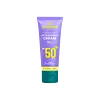What's inside
What's inside
 Key Ingredients
Key Ingredients

 Benefits
Benefits

 Concerns
Concerns

 Ingredients Side-by-side
Ingredients Side-by-side

Water
Skin ConditioningButyl Methoxydibenzoylmethane
UV AbsorberEthylhexyl Salicylate
UV AbsorberEthylhexyl Triazone
UV AbsorberEthylhexyl Methoxycinnamate
UV AbsorberMethyl Methacrylate Crosspolymer
Polyglyceryl-4 Caprate
EmulsifyingPhenoxyethanol
PreservativePolyacrylic Acid
Emulsion StabilisingTriethanolamine
BufferingGlycerin
HumectantCitric Acid
BufferingEthylhexylglycerin
Skin ConditioningParfum
MaskingHelianthus Annuus Seed Oil
EmollientHedychium Coronarium Root Extract
MaskingSodium Polyglutamate
HumectantEthyl Ferulate
AntioxidantRosmarinus Officinalis Leaf Extract
AntimicrobialTocopherol
AntioxidantHydrolyzed Hyaluronic Acid
HumectantWater, Butyl Methoxydibenzoylmethane, Ethylhexyl Salicylate, Ethylhexyl Triazone, Ethylhexyl Methoxycinnamate, Methyl Methacrylate Crosspolymer, Polyglyceryl-4 Caprate, Phenoxyethanol, Polyacrylic Acid, Triethanolamine, Glycerin, Citric Acid, Ethylhexylglycerin, Parfum, Helianthus Annuus Seed Oil, Hedychium Coronarium Root Extract, Sodium Polyglutamate, Ethyl Ferulate, Rosmarinus Officinalis Leaf Extract, Tocopherol, Hydrolyzed Hyaluronic Acid
Water
Skin ConditioningGlycerin
HumectantPropanediol
SolventEthylhexyl Methoxycinnamate
UV AbsorberButyl Methoxydibenzoylmethane
UV AbsorberAloe Barbadensis Extract
Skin ConditioningPortulaca Oleracea Extract
Skin ConditioningSodium Hyaluronate
HumectantNiacinamide
SmoothingCucumis Sativus Fruit Extract
EmollientCamellia Sinensis Extract
AntioxidantPunica Granatum Fruit Extract
AntioxidantPhenoxyethanol
PreservativeOctocrylene
UV AbsorberButylene Glycol
HumectantSodium Acrylates Copolymer
Propolis Wax
EmollientPicea Abies Extract
Skin ConditioningAllantoin
Skin ConditioningXanthan Gum
EmulsifyingPanthenol
Skin ConditioningDisodium EDTA
Chitin
AbrasiveWater, Glycerin, Propanediol, Ethylhexyl Methoxycinnamate, Butyl Methoxydibenzoylmethane, Aloe Barbadensis Extract, Portulaca Oleracea Extract, Sodium Hyaluronate, Niacinamide, Cucumis Sativus Fruit Extract, Camellia Sinensis Extract, Punica Granatum Fruit Extract, Phenoxyethanol, Octocrylene, Butylene Glycol, Sodium Acrylates Copolymer, Propolis Wax, Picea Abies Extract, Allantoin, Xanthan Gum, Panthenol, Disodium EDTA, Chitin
 Reviews
Reviews

Ingredients Explained
These ingredients are found in both products.
Ingredients higher up in an ingredient list are typically present in a larger amount.
Also known as Avobenzone, this ingredient is a chemical sunscreen filter that provides protection in the UV-A range.
Avobenzone is globally approved and is the most commonly used UV-A filter in the world.
Studies have found that avobenzone becomes ineffective when exposed to UV light (it is not photostable; meaning that it breaks down in sunlight). Because of this, formulations that include avobenzone will usually contain stabilizers such as octocrylene.
However, some modern formulations (looking at you, EU!) are able to stabilize avobenzone by coating the molecules.
Avobenzone does not protect against the UV-B range, so it's important to check that the sunscreen you're using contains other UV filters that do!
The highest concentration of avobenzone permitted is 3% in the US, and 5% in the EU.
Learn more about Butyl MethoxydibenzoylmethaneEthylhexyl Methoxycinnamate is an organic compound that provides UVB protection. It often goes by the more common name of octinoxate. It is created from methoxycinnamic acid and 2-ethylhexanol.
Ethylhexyl Methoxycinnamate absorbs UVB rays with wavelengths between 280-320 nm. UV absorbers protect your skin by using chemical reactions to convert UV rays into heat and energy.
UVB (290-320 nm) rays emit more energy than UVA rays. They are capable of damaging DNA, causing sunburns and are thought to be linked to skin cancer.
The state of Hawaii has banned sunscreens containing octinoxate due to its potential impact on coral reefs. More research is needed to bridge gaps in this research. The European Union allows higher levels of octinoxate in sunscreens than the US and Australia.
Ethylhexyl Methoxycinnamate is oil soluble. It is not stable and may lose efficacy when exposed to sunlight.
Learn more about Ethylhexyl MethoxycinnamateGlycerin is already naturally found in your skin. It helps moisturize and protect your skin.
A study from 2016 found glycerin to be more effective as a humectant than AHAs and hyaluronic acid.
As a humectant, it helps the skin stay hydrated by pulling moisture to your skin. The low molecular weight of glycerin allows it to pull moisture into the deeper layers of your skin.
Hydrated skin improves your skin barrier; Your skin barrier helps protect against irritants and bacteria.
Glycerin has also been found to have antimicrobial and antiviral properties. Due to these properties, glycerin is often used in wound and burn treatments.
In cosmetics, glycerin is usually derived from plants such as soybean or palm. However, it can also be sourced from animals, such as tallow or animal fat.
This ingredient is organic, colorless, odorless, and non-toxic.
Glycerin is the name for this ingredient in American English. British English uses Glycerol/Glycerine.
Learn more about GlycerinPhenoxyethanol is a preservative that has germicide, antimicrobial, and aromatic properties. Studies show that phenoxyethanol can prevent microbial growth. By itself, it has a scent that is similar to that of a rose.
It's often used in formulations along with Caprylyl Glycol to preserve the shelf life of products.
Water. It's the most common cosmetic ingredient of all. You'll usually see it at the top of ingredient lists, meaning that it makes up the largest part of the product.
So why is it so popular? Water most often acts as a solvent - this means that it helps dissolve other ingredients into the formulation.
You'll also recognize water as that liquid we all need to stay alive. If you see this, drink a glass of water. Stay hydrated!
Learn more about Water